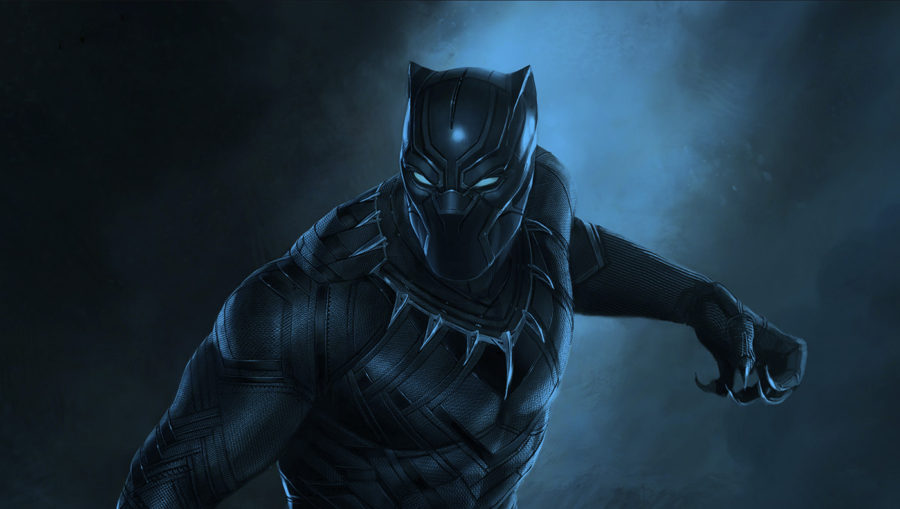The newest superhero movie from Disney’s Marvel Studios has received global attention and adoration. During its first twelve days, ‘Blank Panther’ grossed an estimated $700 million in global ticket sales. It beat out Star Wars: The Last Jedi to become the second biggest debut ever in four-day sales, and is officially the 10th highest grossing film in U.S. history. On February 28th, Variety reported that ‘Black Panther ‘ surpassed ‘Wonder Woman’ and ‘Toy Story 3’ to become the 20th highest grossing film of all time with $421.8 million in sales.
Directed by Ryan Coogler (Fruitvale Station & Creed), the film features an all-star predominantly black cast. It is the first Marvel iteration with a black superhero, moreover, the first with a non-white lead. While this is an action-packed superhero movie, the story does not shy away from issues of race, age-old myths about black men and women, and Afrofuturism. Black Panther takes place in the fictional African nation of Wakanda, a nation free from white supremacy. Actress Lupita Nyongo’o (who plays Nakia in the film) said, “Wakanda is special because it was never colonized, so what we can see there for all of us is a re-imagining what would have been possible had Africa been allowed to realize itself for itself.”
The film is a success all across the board. But ‘Blank Panther’ is more than just the latest superhero movie. For many, this film is a first.
The importance of representation in media
According to a 2017 study from Media, Diversity & Social Change Initiative, 70.8% of the characters in mainstream Hollywood movies were white. Black characters made up only 13.6%, Hispanic 3.1%, and Asian characters made up a small 5.7%. And yet, non-white moviegoers make up nearly half the percentage of ticket sales in the U.S and Canada.
Diverse populations are often not shown in mainstream media. Portrayals of people of color, women, LGBTQ, and those with disabilities are often limited to one dimensional characters. They are the sassy black friend, the heartless boss, or the gay best friend.
For white audiences, representation is the norm. White audiences are allowed to have multifaceted personalities with the belief that they can be anything they want to be: a doctor, a lawyer, a superhero.
Our lives are saturated by media. What we see has a significant impact on the way we view the world. Darnell Hunt, the director of Ralph J. Bunch Center for African American Studies at UCLA, told The Huffington Post, “We’re pretty confident that, the more TV you watch, the more media you consume, the more likely it is that media – almost like radiation – builds up.” When we limit the types of stories we see on screen, we limit the ability for many audiences to engage with stories similar to their own.
Stories effect how we see ourselves and each other. Stories help connect us and help us learn from others’ experiences. More often than not, mainstream media tells one story. They trivialize the struggles, triumphs, and contributions of those who do not see themselves mirrored on screen. It says to these audiences that their stories are less important, or unimportant. Mainstream media teaches these audiences that their place in the world is to be invisible. The term ‘symbolic annihilation‘ is the idea that, “If you don’t see people like you in the media you consume…you must somehow be unimportant.”
Those who are underrepresented in mainstream movies are demanding that their stories be told and Hollywood is being forced to listen. The success of Blank Panther unequivocally proves that mainstream success can come from diversifying the types of stories produced.
Mainstream success
Actress Gabrielle Union explains, “Hollywood is very segregated in how we approach films of color. And no matter how well you do, it is, “You did good for a black movie.”
Get Out and Girls Trip are two films that had a mainstream success. In 2017, Get Out became the highest grossing debut film based on an original screenplay, earned four nominations at the 90th Academy Awards, and won an Oscar in the Best Original Screenplay category. Girls Trip brought in $140.1 million and both films lead to the commercial success of its stars Tiffany Haddish and Daniel Kaluuya.
These successes proved that films featuring a predominantly black cast, films that highlight stories of non-white audiences are possible (and profitable).
Journalist Jamil Smith said: “This is not just a movie about a black superhero; it’s very much a black movie. It carries a weight that neither Thor nor Captain America could lift: serving a black audience that has long gone underrepresented. For so long, films that depict a reality where whiteness isn’t the default have been ghettoized, marketed largely to audiences of color as niche entertainment, instead of as part of the mainstream.”
Black Panther celebrates blackness in a way not normally seen on screen. Women of color are celebrated as leaders, scientists, and revolutionaries. T’Challa, the film’s protagonist and king of Wakanda, is a multifaceted black hero. Wakanda is a nation not under the rule or horrors of white colonialism. Africa is often portrayed as savage and chaotic in mainstream media, Wakanda is anything but. It is an advanced, vibrant, and flourishing nation.
To this end, ‘Black Panther’ is a cultural phenomenon. “It was amazing. It was an amazing experience for me to listen to her reactions and responses as she watched the film,” Author Robyn C. Spencer states as she recalls seeing the film with her 12 year old daughter. “She marveled at the African-American women and the African women, how they were portrayed, their strength, just the sheer number and volume of women that appeared.”
For many, this is the first time they are seeing blackness being celebrated in such a way on screen. Films like Get Out and Girls Trip have paved the way for the groundbreaking success of Black Panther. “But Black Panther matters more,” says Jamil Smith, “because he is our best chance for people of every color to see a black hero. That is its own kind of power.”
#wakandaforever
We know that stories are essential to connection. The consequences of a single story is detrimental to the success and progress of society. Not only does Blank Panther prove that a black superhero film can have success with every audience, it opens up the conversation and door for other stories to be told. But it also allows for a wider discussion on the rights and stories of people of color in our country.
In speaking on a round table discussion with Democracy Now, Robyn C. Spencer said, “To me, that is what this moment is about, that it’s a moment where we can make those connections tangible and real. I think that the film is imperfect. I write about that in my piece. But it’s also clay, I feel like, and we can make of it what we want. This is why organizers are taking to the streets talking about the real Black Panther Parties, like, “You want to hear about superheroes? We’ll tell you about Sekou Odinga. We’ll tell you about Mumia Abu-Jamal. We’ll bring these real Black Panthers to the fore at this moment.”
It’s time.
Time for white audiences to sit down and listen. Time for those whose stories are not often portrayed to be presented to a mainstream audience. Time for audiences that make up almost half of all moviegoers in North America to see unique, diverse, multifaceted perspectives with characters who look like them.
“Words can’t even describe what this movie has meant to me and to other black people,” a fan tells Boseman on Jimmy Fallon, “And I know this is for you Chadwick, but I wanted to take a second to thank the black women, too. Because they were so strong on their own terms and answer to no one but themselves, and I think it was so important because they weren’t strong because they were angry. They weren’t strong because they were hurt. They were strong because they were strong. And that meant the world to me. So thank you. Wakanda forever.”






